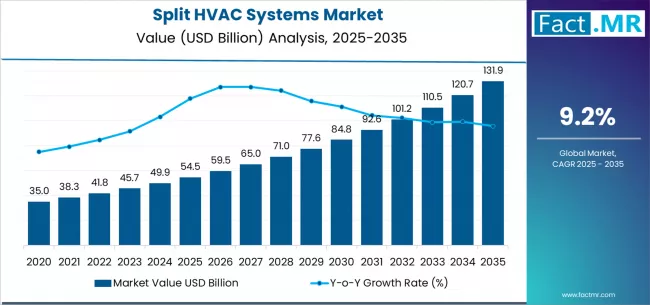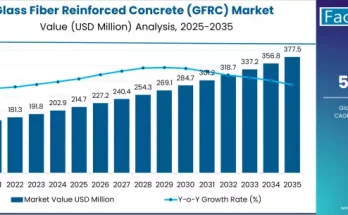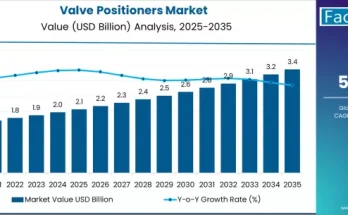The global split HVAC systems market is poised for significant expansion over the next decade, driven by rising demand for energy-efficient climate control solutions, rapid urban development, and increasing adoption of smart home technologies. According to a new analysis by Fact.MR, the market is projected to grow from USD 54.5 billion in 2025 to approximately USD 131.9 billion by 2035, reflecting an impressive CAGR of 9.2% and an absolute increase of USD 77.4 billion during the forecast period.
As consumers and businesses prioritize energy savings, indoor comfort, and environmentally responsible systems, split HVAC units—known for their high performance, flexibility, and low installation costs—are emerging as preferred climate control solutions across residential, commercial, and industrial spaces.
Strategic Market Drivers
Energy-Efficient Cooling Becomes a Global Priority
Growing awareness of rising energy bills, carbon emissions, and environmental sustainability is fueling the demand for high-efficiency cooling and heating systems. Split HVAC units, equipped with inverter technology, advanced compressors, and precise temperature controls, offer substantial reductions in power consumption. Global policies promoting green buildings and energy labeling continue to accelerate their adoption.
Smart Controls & IoT-Based Automation Gain Traction
The integration of IoT-enabled thermostats, AI-driven sensors, and app-based monitoring is transforming split HVAC performance and user experience. Remote control features, predictive maintenance, and personalized climate settings are helping consumers achieve improved comfort levels with reduced operational costs.
Browse Full Report: https://www.factmr.com/report/split-hvac-systems-market
Urban Infrastructure Growth Boosts Market Penetration
Rapid construction of residential complexes, commercial buildings, and industrial facilities across Asia, the Middle East, and Latin America is increasing the demand for modern HVAC systems. Split units offer cost-effective installation, flexible zoning capabilities, and low maintenance, making them ideal for diverse infrastructure types.
Technological Innovations Improve Performance and Sustainability
Advancements in refrigerants, airflow optimization, noise reduction, and smart diagnostics are making new-generation split HVAC systems more eco-friendly and user-friendly. Manufacturers are increasingly focusing on R32 and other low-GWP refrigerants to comply with global emission standards.
Regional Growth Highlights
North America: Smart Homes and High-Efficiency Standards Drive Demand
The U.S. and Canada are witnessing strong uptake of inverter-based split systems due to rising smart home penetration, energy regulations, and growing consumer preference for cost-effective cooling and heating solutions. Replacement demand remains a key growth driver.
Europe: Sustainability and Low-GWP Compliance Shape Market Trends
Europe’s focus on green buildings, heat pump integration, and low-refrigerant-emission systems is steering innovations in split HVAC technologies. Countries such as Germany, the U.K., Italy, and France are investing in energy-labelled HVAC infrastructure.
East Asia: Largest and Fastest-Growing Market
China, Japan, and South Korea lead global production and consumption, supported by rapid urbanization, high-rise housing developments, and technological advancements. Government incentives for energy-efficient appliances continue to boost market penetration.
Emerging Markets: Massive Growth Potential
India, Southeast Asia, GCC countries, and Latin America are witnessing rising adoption due to expanding middle-class populations, hot climate conditions, and increasing real estate activities. Affordable inverter models and financing schemes are further driving uptake.
Market Segmentation Insights
By System Type
- Mini-Split Systems – Dominant due to easy installation and zoning flexibility.
- Multi-Split Systems – Increasing adoption in large homes and commercial spaces.
- VRF/VRV Systems – Fast-growing segment with high efficiency for multi-room applications.
By End Use
- Residential – Leading segment driven by home renovation and smart home integration.
- Commercial – Rapid growth in retail, offices, hospitality, and educational institutions.
- Industrial – Increasing adoption for climate-sensitive operations and facilities.
By Refrigerant Type
- R32 – Preferred low-GWP and high-efficiency refrigerant.
- R410A & Others – Gradually being phased out in many regions due to emission regulations.
Challenges Impacting Market Growth
- High Initial Installation Costs – Advanced split systems require higher upfront investment.
- Shortage of Skilled Technicians – Impacts installation quality and service reliability.
- Regulatory Changes in Refrigerants – Frequent shifts in environmental norms require system upgrades.
- Competition from Central HVAC & Heat Pumps – Alternative systems expand in urban markets.
Competitive Landscape
The split HVAC systems market is moderately consolidated, with global leaders expanding through innovation, energy-efficient models, and smart technology integration.
Key Companies Profiled
- Daikin Industries
• Mitsubishi Electric
• LG Electronics
• Samsung Electronics
• Carrier Global Corporation
• Panasonic Corporation
• Johnson Controls
• Fujitsu General
• Hitachi Air Conditioning
• Trane Technologies
Manufacturers are advancing inverter technologies, AI-enabled controls, quiet-operation designs, and eco-friendly refrigerants to strengthen market presence.
Recent Developments
- 2024: Multiple manufacturers introduced AI-enabled split HVAC units with adaptive climate sensing and energy-optimizing algorithms.
- 2023: Surge in inverter-based split system installations across Asia and the Middle East due to growing urban housing.
- 2022: New energy-efficient models with R32 refrigerants launched in Europe, aligned with carbon-reduction policies.
Future Outlook: A Decade of Smart, Sustainable Climate Control
The split HVAC systems market is set to witness strong and sustained growth through 2035, supported by rapid technological advancements, energy-efficiency reforms, and rising demand for smart climate control solutions. As consumers shift toward eco-friendly and intelligent HVAC systems, manufacturers that invest in sustainable refrigerants, digital platforms, and high-performance technologies will lead the next generation of global HVAC innovation.
With widespread adoption across residential, commercial, and industrial sectors, the split HVAC systems market is positioned for robust expansion and transformative development over the coming decade.



